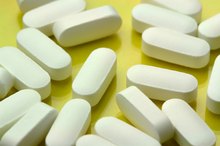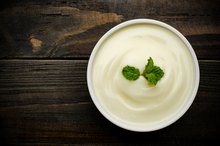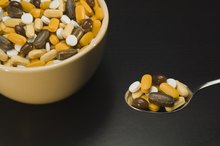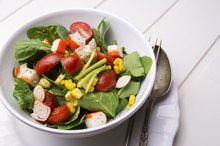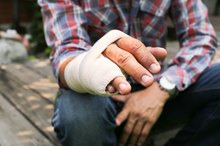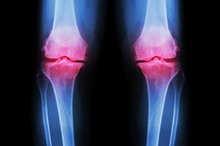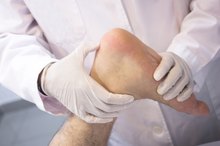The Best Foods for Healing Broken Bones
If you’re dealing with a broken bone, you’re far from alone. According to Ohio State University, 6 million people in the U.S. break a bone every year 1. While there’s no magic bullet, bone fracture healing foods include those rich in vitamins D, C and K and minerals calcium, phosphorus and magnesium 4.
Food to Heal Broken Bones
Anyone can break a bone. Blunt impact during a sports match, a car accident or a particularly bad fall can cause even the healthiest of bones to exceed its breaking point. The American Academy of Orthopedic Surgeons reports that, in addition to those traumatic events, overuse, or repetitive movements that fatigue the muscles, can put additional stress on bones that causes them to fracture 2.
Another common cause of broken bones is osteoporosis, a condition in which the density and quality of bone deteriorates. The bones become porous, brittle, fragile and prone to breaking.
Several factors contribute to the development of osteoporosis, including age and sex — women over age 50 have a 50 percent risk of breaking a bone because of osteoporosis, according to the National Osteoporosis Foundation 3. Nutrition is also a major factor, and eating disorders such as anorexia and bulimia also contribute to weakened bones and the development of osteoporosis.
Read more: 8 Foods for Healthy Bones (and 3 Foods That Negatively Impact Bone Health)
- Blunt impact during a sports match, a car accident or a particularly bad fall can cause even the healthiest of bones to exceed its breaking point.
- Another common cause of broken bones is osteoporosis, a condition in which the density and quality of bone deteriorates.
Calcium and Vitamin D
What Is Tricalcium Phosphate?
Learn More
Chances are you've heard the hype about drinking milk to maintain strong bones. That's not just a marketing ploy. Milk and other dairy products are rich sources of the mineral calcium — the most abundant mineral in the human body — that provides the structure of bones and teeth 4.
Adequate amounts of calcium are necessary for bone remodeling, the continuous process the bones go through to break down old bone and redeposit calcium to build new bone — a process that's crucial to healing after a bone injury 4.
But calcium doesn't work alone 4. Vitamin D is required for proper absorption of calcium in the gut; without enough vitamin D, your blood levels of calcium drop, and normal bone remodeling can't occur 459.
Maintaining adequate levels of calcium and vitamin D is crucial throughout your lifetime to prevent osteoporosis and future fractures 459. After breaking a bone, low levels of vitamin D and calcium are especially problematic because their effect on how well and how quickly the bone heals, according to a research review published in the Journal of Osteoporosis in December 2017 459.
Make sure to meet the minimum daily intake recommended by the Food and Nutrition Board of the National Academies of Medicine, which is 1,000 milligrams for all adults ages 19 to 50 years old 7. From ages 51 to 70, men still need 1,000 milligrams, but women's needs increase to 1,200 milligrams daily. After age 71, both men and women need 1,200 milligrams each day.
The best sources of calcium foods to heal broken bones are dairy foods, including milk, cheese and yogurt 4. If you don't eat dairy, meeting your calcium needs can be a little more difficult 4. Canned salmon with bones, tofu made with calcium sulfate and fortified juices and cereals are non-dairy sources of calcium, but may not be enough to meet your calcium needs alone 4. Your doctor can tell you whether supplemental calcium is necessary for you 4.
Vitamin D needs are also challenging to meet through diet alone, since few foods contain the nutrient, according to the National Institutes of Health (NIH) 5912. Adults between the ages of 19 and 70 need 600 international units daily. Over the age of 70, men and women need 800 international units daily. Dietary sources include swordfish, salmon and tuna, as well as fortified milk, juice and cereal.
Cod liver oil is an especially rich source. You can also meet your vitamin D needs through direct exposure to the sun's UVB rays; however, due to the dangers of skin cancer, this isn't recommended 5912. Vitamin D deficiency is common, so speak with your doctor about whether you need a supplement 5912.
- Chances are you've heard the hype about drinking milk to maintain strong bones.
- The best sources of calcium foods to heal broken bones are dairy foods, including milk, cheese and yogurt 4.
Foods With Vitamin C
Vitamin C, or ascorbic acid, is a critical nutrient for the production of collagen, the most abundant type of protein in the human body that forms 90 percent of the matrix of your bones, according to the University of Washington 589. Vitamin C deficiency is rare in developed countries, reports NIH, but vitamin C inadequacy is a risk for certain populations, including 5912:
- Smokers and secondhand smokers
- People with malabsorption disorders or chronic diseases
- People with limited diets
The recommended daily intake of vitamin C is 90 milligrams for men, 75 milligrams for women, 85 milligrams for pregnant women and 120 milligrams for breastfeeding women 5912. Eating a varied diet typically provides enough vitamin C for most people, according to the NIH 5912. If you believe you are not getting enough of the nutrient, focus on increasing your intake of fruits and vegetables, including bell peppers, citrus fruits, broccoli, strawberries and Brussels sprouts.
Read more: Everything You Need to Know About Vitamin D
Other Nutrients for Bone Health
What Are the Daily Values of Calcium for a 2000 Calorie Diet?
Learn More
Phosphorus and magnesium are two minerals found in the body's bone crystal, and both improve bone strength and growth 4. Most people can get enough of these nutrients through a well-balanced diet, reports the American Academy of Orthopaedic Surgeons, except for older adults who have a higher risk of magnesium deficiency 2410.
The recommended daily intake of phosphorus is 420 milligrams for males, 320 for females, 350 milligrams for pregnant women ages 19 to 30, 360 milligrams for pregnant women ages 31 to 50, 310 milligrams for breastfeeding women ages 19 to 30, and 320 milligrams for breastfeeding women ages 31 to 50.
The best dietary sources of this mineral are salmon, halibut, turkey, yogurt, milk, chicken, beef, lentils and almonds, according to the Linus Pauling Institute at the University of Oregon 11. All adults need 700 milligrams of magnesium a day, which can be found in nuts, spinach, beans and fortified breakfast cereals.
Last, vitamin K is another vitamin for bone healing that is involved in bone formation and mineralization 5912. Most people get adequate amounts of vitamin K in their diets, reports NIH, but people with malabsorption disorders may need increased amounts of the nutrient 5912. Leafy green vegetables, such as collard greens, turnip greens, spinach and kale are the richest sources of vitamin K 5912.
- The recommended daily intake of phosphorus is 420 milligrams for males, 320 for females, 350 milligrams for pregnant women ages 19 to 30, 360 milligrams for pregnant women ages 31 to 50, 310 milligrams for breastfeeding women ages 19 to 30, and 320 milligrams for breastfeeding women ages 31 to 50.
- All adults need 700 milligrams of magnesium a day, which can be found in nuts, spinach, beans and fortified breakfast cereals.
Related Articles
References
- Ohio State University: "Arm Injury Statistics"
- American Academy of Orthopaedic Surgeons: "Fractures (Broken Bones)"
- National Osteoporosis Foundation: "What Women Need to Know"
- NIH: "Calcium"
- NIH: "Vitamin D"
- Journal of Osteoporosis: "Nutritional Aspects of Bone Health and Fracture Healing"
- National Academies of Medicine: "Summary Tables, Dietary Reference Intakes"
- NIH: "Vitamin C"
- American Academy of Orthopaedic Surgeons: "Calcium, Nutrition, and Bone Health"
- University of Oregon: "Phosphorus"
- NIH: "Vitamin K"
- Bliuc D, Nguyen ND, Nguyen TV, et. al. Compound risk of high mortality following osteoporotic fracture and refracture in elderly women and men. J Bone Miner Res. 2013;28(11):2317-24. doi:10.1002/jbmr.1968
- Bailey RL, Dodd KW, Goldman JA, et al. Estimation of total usual calcium and vitamin D intakes in the United States. J Nutr. 2010;140(4):817-822. doi:10.3945/jn.109.118539
- National Institutes of Health. Calcium fact sheet for health professionals. Updated March 26, 2020.
- Parva NR, Tadepalli S, Singh P, et al. Prevalence of vitamin D deficiency and associated risk factors in the US population (2011-2012). Cureus. 2018;10(6):e2741. doi:10.7759/cureus.2741
- National Institutes of Health. Vitamin D fact sheet for consumers. Updated March 24, 2020.
- Cleveland Clinic. Osteoporosis: Prevention with calcium treatment. Updated October 15, 2015.
- Li K, Wang XF, Li DY, et al. The good, the bad, and the ugly of calcium supplementation: a review of calcium intake on human health. Clin Interv Aging. 2018;13:2443-2452. doi:10.2147/CIA.S157523
- Marcinowska-Suchowierska E, Kupisz-Urbańska M, Łukaszkiewicz J, et al. Vitamin D toxicity—a clinical perspective. Front Endocrinol (Lausanne). 2018;9:550. doi:10.3389/fendo.2018.00550
Writer Bio
Jody Braverman is a professional writer and editor based in Atlanta. She studied creative writing at the American University of Paris and received a Bachelor of Arts in English from the University of Maryland. She also received personal trainer certification from NASM and her 200-hour yoga teacher certification from YogaWorks.
